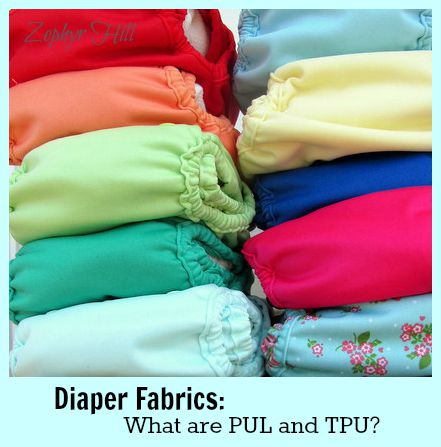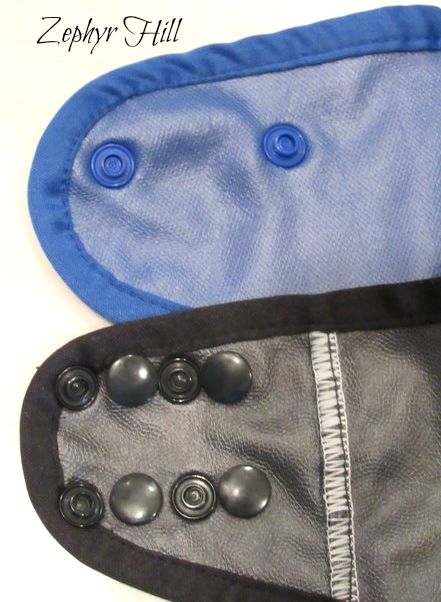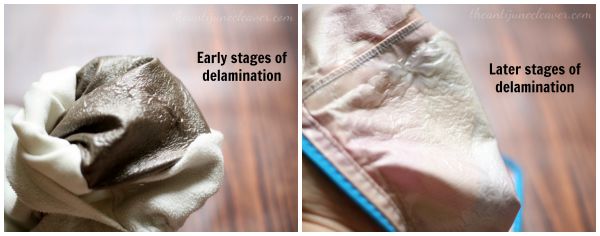Most waterproof poly cloth diapers are marketed as being made with PUL. However, some diapers are described as being made from “TPU,” which gives the impression that TPU is a completely different fabric. In fact, TPU is not a fabric at all. Let me explain because I was pretty confused until I spent way too much time last week doing some research. Here’s what I learned.
TPU is Not Really a Fabric
First of all, here’s what the acronyms stand for:
- PUL is Polyurethane Laminate
- TPU is Thermoplastic Polyurethane
So while PUL is a fabric, TPU is simply the thin, stretchy and clear film of polyurethane plastic that is bonded to poly knit to make PUL. So PUL and TPU are not two separate fabrics. TPU is actually a part of PUL. Then why are some diapers described as being made of TPU? It’s just a marketing term that’s used to distinguish the type of laminating process used.
Not Your Mama’s PUL
For the longest time, PUL fabric was laminated exclusively using strong chemical solvents. Fabrite PUL was the biggest name in the industry, and it was tough stuff that could actually be boiled. You still see people recommending this from time to time in diaper forums, because traditional advice takes a long time to catch up with change.
More recently, a new process was developed for laminating polyester without the use of chemical solvents. It is thermally bonded with heat and pressure. The resulting PUL is softer, more pliable, and more green (I’ll discuss the eco-friendly claims further on). Called TPU by many, it is still actually PUL, as explained above. A little confusing, I know. It’s more correct, and less confusing, to call TPU “thermally bonded PUL.” In fact, I’ll use that term going forward in this post to avoid more confusion.
More diapers than you may realize on the market today are made using this thermal bonding process. In fact, some of the brands that you assume are using the “old” style of PUL are actually using thermally-bonded, whether it’s advertised that way or not (examples: bumGenius and Thirsties and AppleCheeks). Thermally-bonded PUL is rapidly becoming the standard, although solvent laminated PUL is still manufactured.
This pictures shows the clear, laminated TPU backing on two waterproof PUL diaper covers. The blue one is Buttons and the black is Sweet Pea.
And now a few questions I wanted to find answers to.
QUESTION #1 Is old-school PUL tougher than the newer, thermally-bonded PUL?
If you’re talking about the solvent-based PUL, then yes. As mentioned above, some of the older fabrics could withstand boiling. Most of the PUL that’s in use now should not be. But that’s not to say that thermally-bonded PUL isn’t tough and durable. To find out just how much, I checked with a few textile manufacturers.
AKASTex LLC, manufacturer of AKASoft PUL, states in regards to their thermally laminated product: “In lab testing, this product has survived a minimum of 200 laundry cycles without delaminating or leaking.”
Does it crack more easily? Wazoodle says that its DiaperMaker PUL is made with a liquid adhesive that melt-bonds to the fabric. “The special Polyurethane Reactive Adhesive is liquefied and applied between the fabric and the film using a discontinuous technique. The adhesive then reacts with the moisture in the air to become crosslinked, converting the material from a thermoplastic to a thermoset, a property that gives the laminate permanent strength without the need for curing and allows the PUL to be dried at lower temperatures, so it helps save energy. Such PUL will also not crack and break…”
In a communication to me, Diaper Sewing Supplies confirmed that their thermally-bonded PUL (the product name is Eco-PUL) can withstand 100 autoclave cycles and temperatures up to 212 degrees. It could potentially withstand more, but hasn’t been tested beyond those parameters. Most PUL manufacturers comfortably place their thermally-bonded PUL in the 200-300 wash cycle range, which equates to reliable performance for at least 1.5 to 2 years (if you wash every two days) and 3 years or more if you washed every three days. I’m sure most of you can attest to diapers in your stash that have made it past the 2 or 3 year mark. I definitely can. The idea that (so-called) TPU is much more “delicate” than PUL is just a myth.
What about cloth diaper brands themselves? Seems to me that if the newer, thermally-bonded PUL was not as sturdy, they would let us know. Maybe they would even limit their warranties. But neither is true. Warranty coverage for laminated components is all over the place; they range from very limited to a full year regardless of what type of PUL is used. However, it’s important to keep proper care of the fabric in mind, as recommended by the maker.
Cloth Diaper Warranties:
bumGenius/Flip/Econobum (1 year)
Blueberry (1 year)
Bummis (up to 100 washes for waterproof components – this equates to 6-12 months of use)
Buttons Diapers (90 days)
Best Bottoms (60 days)
Imagine (60 days)
AppleCheeks (1 year)
GroVia (1 year)
Rumparooz (6 months)
Sweet Pea (1 year)
Diaper Rite (6 months)
Kawaii (60 days)
Bumkins (30 days, but possibly longer)
Thirsties (1 year)
Motherease (lifetime on the PUL component)
Even though many types of PUL are made to withstand a lot of wear and tear and heavy-duty cleaning, it’s important to remember that all PUL is not created equally. And when you’re talking about fabric sourced overseas, there is less of a guarantee when it comes to quality and durability (i.e. imported or re-branded diapers from China).
What happens when PUL begins to break down? It’s called delamination and it basically means that the TPU film is separating from the poly fabric. It usually happens in stages as time goes by. Improper care can also accelerate it.
Here are two examples of diaper delamination, courtesy of my friend, Regan, at The Anti June Cleaver:
QUESTION #2 Is thermally-bonded PUL more environmentally friendly?
That would be a resounding yes.
According to Wazoodle, “Thermally laminated PUL fabric using a TPU film is similar to the solvent laminated PUL fabric, but it is manufactured in a more environmentally friendly way than the solvent laminated PUL.”
What gives it an edge? AKASTex LLC (who purchased Wazoodle in 2012) says “…the manufacturing process has no discharges of VOC [Volatile Organic Chemicals] or solvent fumes which helps keep air clean, and generates no solid waste, thereby supporting our efforts towards a clean environment while supplying our customers a high-quality product.”
I asked one of the chemists at AKASTex about the claim that thermally-bonded PUL is more eco-friendly because it doesn’t use chemicals. First of all, the thermal bonding technically is a chemical process, but it’s physical chemistry (the structure is changed using heat, pressure and adhesive). So no actual harsh chemical solvents are used to achieve lamination.
I also asked if older versions of PUL could potentially leach chemicals throughout the lifespan of the diaper (during use and laundering). He responded, “Yes, there is a potential for that.” As far as toxicity levels go, I haven’t been able to find any hard facts. However, I’m sure you’ve heard of babies being sensitive to certain types of PUL. Could the chemical solvents be responsible? If these babies were put in thermally-laminated diapers, would the problem go away? Interesting questions for thought.
QUESTION #3 Is thermally-bonded PUL biodegradable?
I can’t get a definitive answer on this. It’s a fact that synthetic polyesters are not really biodegradable – and as we’ve learned, so-called TPU is still PUL. It’s a poly fabric laminated with a plastic film. A complete breakdown of any polyester/plastic fabric could take 200 years or more.
Diaper Sewing Supplies (the above-mentioned producers of EcoPUL) told me that their more environmentally-friendly thermal-bonded PUL is not biodegradable, but some brands do market their product as being biodegradable.
So the jury is still out on this one, but a truly biodegradable PUL diaper would certainly be yet another laurel in the #makeclothmainstream crown!
QUESTION #4 Is thermally-bonded PUL more breathable than regular PUL?
Eco-PUL™ Textiles describes their thermally-bonded PUL thus: “…the adhesive dot pattern that you see on the reverse (laminate) side of our PUL fabric allows for optimal vapor transmission – it releases heat and moisture as it is worn, keeping the wearer comfortable.
Diaper Sewing Supplies, the distributor and official contact for Eco-PUL says “The most important characteristic of Eco-PUL™ is that it forms a waterproof barrier, while still being breathable. In this context, breathable does not mean that you can hold the fabric over your face and breathe through it. It means that the fabric releases heat and water vapor.”
Wazoodle echoes the same. The clear TPU film being used has to allow for the transmission of air, but not water. And the process of lamination itself cannot compromise the release of vapor.
QUESTION #5 If PUL is so tough, why are we warned about high heat and the sanitize cycle?
It’s a pretty standard recommendation from both manufacturers and brands that PUL diaper covers shouldn’t be tumble dried on high heat, or subjected to the sanitize cycle in a washing machine. Why the special care if this is a fabric that can withstand high temperatures?
Well, like any fabric on the market, not all PUL is the same. It can vary in durability, waterproofing, and the max temperature it can withstand. If you need PUL for a special use, like in a medical setting where it can be autoclaved, ask the manufacturer about the specs before purchasing.
For the PUL that is used for cloth diapers, prolonged exposure to heat is not recommended for a few reasons. The aforementioned chemist explained this mystery to me.
In the dryer, there is a small risk of the TPU (plastic film) laminated side touching the dryer drum. If that happens, it can potentially soften or melt just like any plastic would. Even if using the low setting, you can take extra precautions by snapping or fastening the cover during drying, so that the plastic side is not exposed.
In the washer, the sanitize cycle works very differently from an autoclave. Items in an autoclave are carefully loaded, and they don’t touch the walls of the autoclave. Super hot steam circulates around the items and sanitizes them. Temperature controls and times are very exact and strictly regulated. No water is used inside.
CONCLUSION
The next time someone says “I like TPU better than PUL,” you’ll know that there’s not really a difference. What we call TPU is actually PUL.
And when it comes to any cloth diaper, remember that it’s not all the same quality. That’s why it makes sense to follow the brand or the manufacturer’s care recommendations and not simply advice you see floating around the internet (boil vs. don’t boil, tumble dry vs. line dry, don’t buy TPU because it delaminates more easily, etc. etc.) Sarah, a veteran cloth diaper maker and seller of DiaperFab textiles told me, “The quality of any fabric depends so much more on where you’re getting it from than on what the person selling it to you chooses to call it.” Look for quality behind the name.




Very interesting- thanks for a great article! Before I knew what it meant, I preferred the feel of diapers advertised as TPU because they just seemed softer and more stretchy. (I’m a Rumparooz addict.) After reading this I realize they use similar processes, but it’s interesting that some still feel so different!
I completely agree, Keara! The feel is so much nicer. The first “TPU” diaper we tried was actually Erik’s Rumparooz newborn cover. ~Anne PS: There is a RaR pocket diaper review/giveaway going live this week!
Thank-you for this!!
Hi Anne, I really liked the way you have written this article and I shared the link on our Facebook page but at least two people have said they are not able to read it as the page gets redirected to an ad. Could you look into that and see what’s going on? Thank you. ArchAna
I think we got all the kinks worked out, Arch. Thanks for bringing it to my attention! Hope your readers will be able to view it now. – Anne
Thank you Anne, I will let the readers know. Thanks again. Arch
Anne, thank you for the quick response and fix, the readers have informed they had no more problems accessing the information. Thank you so much. Arch
Glad to help, Arch, and thanks for bringing it to my attention. ~Anne
Very Good Post, helped me alot for understanding the term. thanks for the post.
Finally, a good explanation of PUL vs TPU – and so simple to understand!